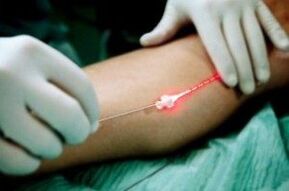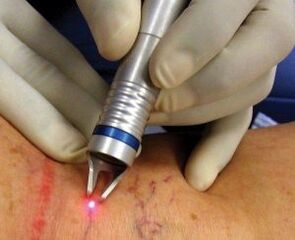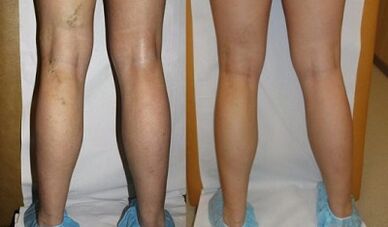
Treating varicose veins with lasers is a modern and effective way to get rid of this disease.
Laser therapy uses a focused beam, which results in venous damage and intraluminal growth of connective tissue.The blood flowing through the slender veins stops, causing the disease symptoms to disappear.
Principles of surgery
If the patient has varicose veins on the leg, laser treatment is performed with the aim of thermal effects on the container wall.This effect is caused by irreversible decline, replacement of connective tissue and disappearance of dilated blood vessels.
The main mechanism of action is to heat the blood with the formation of steam, which can damage the blood vessel walls.Diode lasers and fiber structures with different sizes are used.
To compile varicose veins, ultrasound Doppler studies were used.Introduce analgesic drugs into the intervention area.A very thin fiber is introduced into the varicose veins, from the tip of the laser beam.
The energy of the laser is converted into heat.The temperature inside the container reaches 60-70 degrees.The effect of heat on the venous wall causes it to "adhese".Subsequently, as time goes by, the scleral veins are absorbed.
Indications
Laser treatment of varicose veins is performed in two main ways:
- Percutaneous;
- Intravascular (intravascular).

Bearing laser therapy helps get rid of blood vessel stars and small swelling subcutaneous veins.This process is performed for plastic surgery purposes.It can be used as a second stage treatment after eliminating large varicose veins.
Intravascular methods are used to eliminate large varicose veins.
If you have varicose veins on your legs, laser treatment allows you to affect such blood vessels:
- Subcutaneous size;
- Extra subcutaneous front and rear;
- superficial skin;
- Anterior and posterior envelope of the femur.
Obese patients are particularly showing laser therapy because it is technically difficult or can lead to complications.
Indications for intravascular coagulation:
- Ineffective valve operation, accompanied by edema (reflux of resetting exceeds 0.5 s);
- Nutritional Diseases: Changes in color and skin density, dryness and skin itching;
- Haas ulcer, difficult to treat.
Shows the main symptoms of laser treatment:
- lomota on the legs;
- Severity and fatigue;
- The feeling of pulsation;
- Itchy skin;
- Twitch at night;
- Bleeding under the skin.
Skin changes:
- Vascular star, eczema, color change;
- The focus of white and atrophy of the skin;
- ulcer;
- swelling;
- Inflammation of surface veins.
Contraindications
Intravascular laser treatment is contraindicated in the following situations:
- Anesthesia can damage the child's pregnancy and breastfeeding;
- Difficulty of blood flowing through deep veins, which will prevent blood from flowing out normally after surgery;
- liver failure or allergies to painkillers;
- Blood clotting disease;
- It is impossible to perform appropriate outpatient treatment and observation after intervention;
- Blood casting (reflux) of vertical veins;
- Thrombosis, adhesion or tolerance of veins.
Advantages of this method

Laser coagulation in veins is a safe and effective method for treating varicose veins in the outpatient clinic under local anesthesia.This process takes 1-1.5 hours.Most patients were satisfied with the treatment results.
The total cost of intervention is lower than that of surgical procedures.It has an effectiveness of 93-100% in 3 months to 4 years.
Laser therapy does not cause scars and scar formation.It is well tolerated and allows you to quickly resume normal activities.The side effects of this process rarely occur.
defect
Laser treatment of varicose veins can be accompanied by the following consequences:
- Skin burns;
- Changes in skin tone;
- damage to nearby nerves accompanied by burning or tingling (this probability is much lower than usual when operated);
- Vienna thrombosis.
The more doctors who use lasers to remove ships on their legs, the better the results of treatment will be.
Internal oxygen coagulation is not possible along the coast of the veins to treat large varicose nodes and blood vessel diameters exceeding 1 cm.
suggestion
Several sessions are required for credit treatment with a laser of varicose veins.They are held at intervals of 6-12 weeks.
Endovascular treatment was performed using thin fibers introduced into the veins under ultrasound control.This is a short recovery process.It is performed under local anesthesia.
After performing laser removal of blood vessels, the patient can walk almost immediately and quickly return to normal life.Within one week after the surgery, it is recommended to wear compression stockings with a compression degree II (30-40 mm Hg) or elastic bandage.
It is recommended to walk 1 to 2 hours a day for 2 weeks.Currently, it is necessary to give up on hot baths, running, jumping, weightlifting and tension.
If pain or discomfort occurs, you can take anti-inflammatory drugs.
One month after the intervention, and then repeated examinations and ultrasound were performed on the veins after 1 year.This allows you to evaluate the effectiveness of the completion process.
Alternative Method
When laser clotting of the vein is not shown, it is necessary to consider the use of other methods of treating varicose veins:
- Drug-bound elastic compression;
- Radio frequency ablation - use radio waves to destroy and block containers;
- Sclerotherapy - Luminal prisons for chemical substances;
- Ovalectomy - surgical removal of the vein.
Intravascular laser treatment for varicose veins is an excellent method that can effectively get rid of 90% of patients for 3 to 4 years of illness.It is rarely accompanied by serious complications.The advantage of laser is that there is no scar after surgery and a rapid recovery period.

















